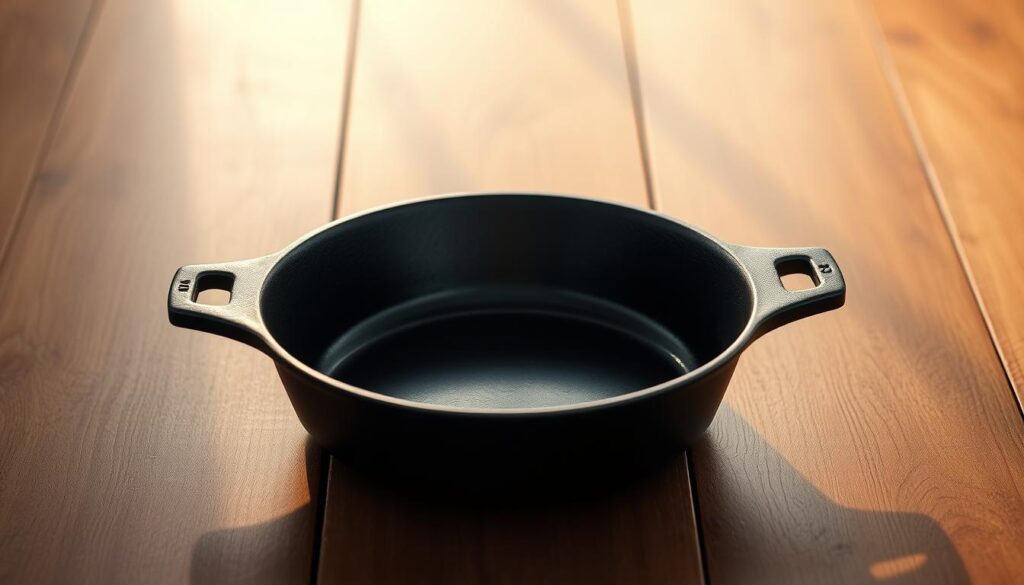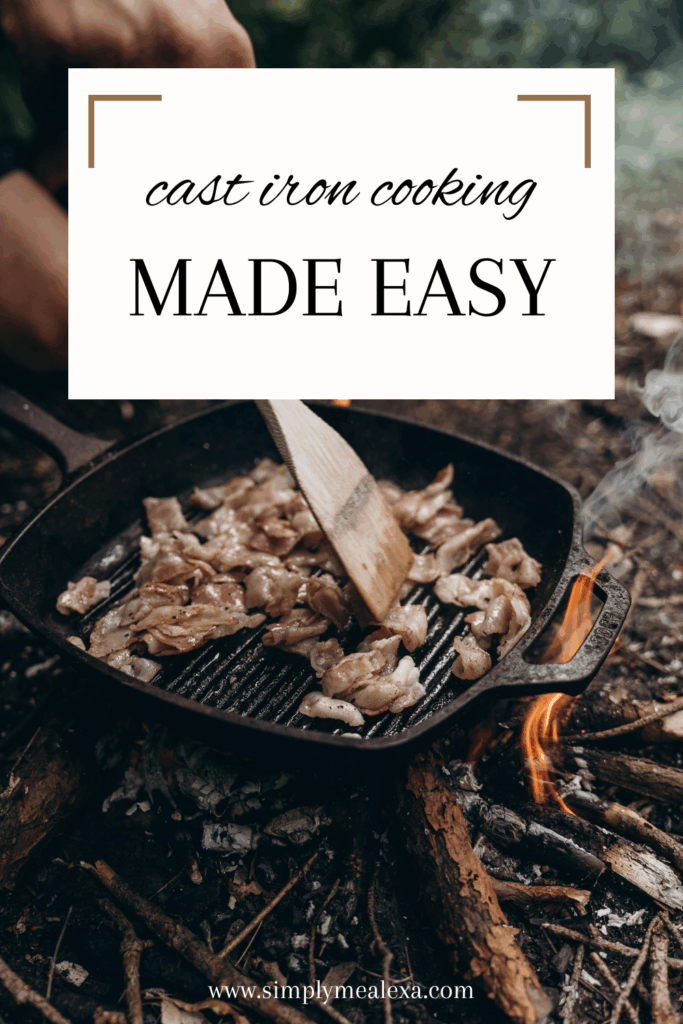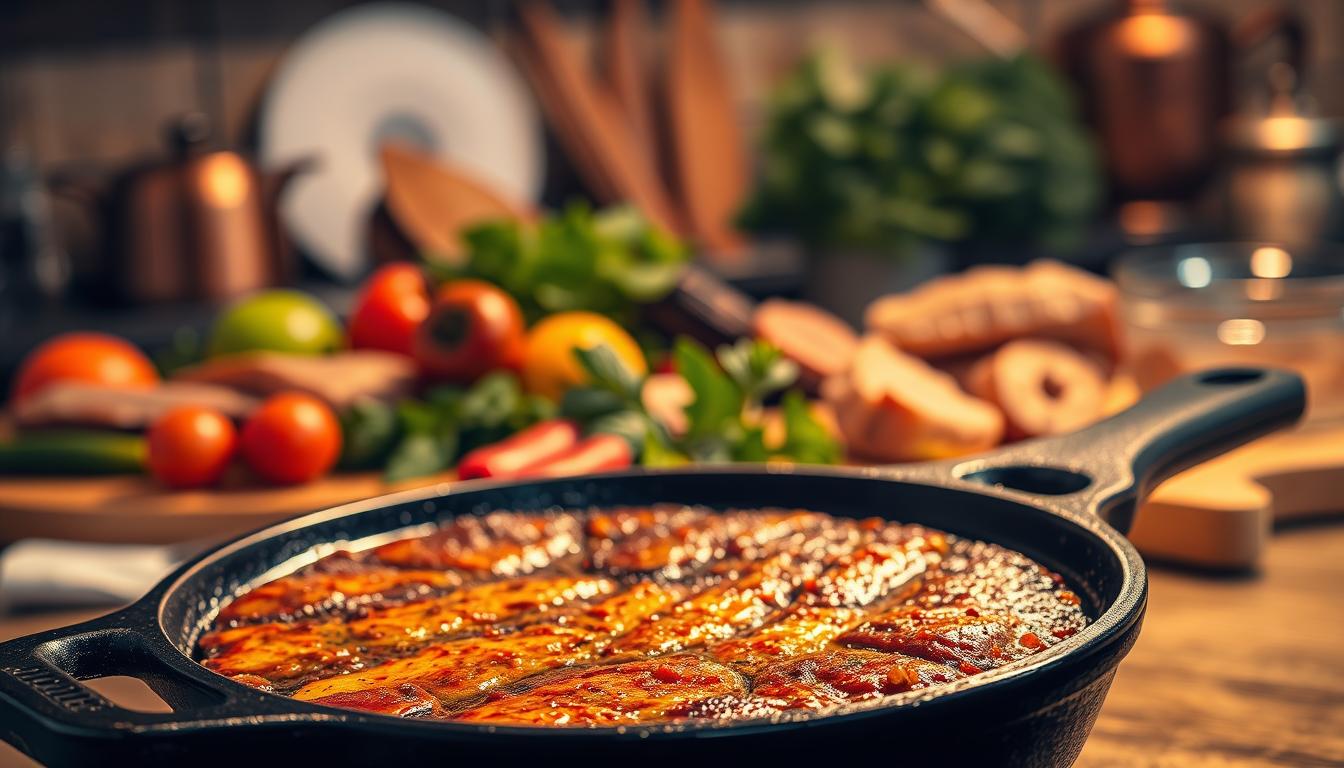Heads up: this post includes affiliate links. If you decide to grab something through one of my links, I may earn a small commission at no extra cost to you. I only share products I actually use or genuinely recommend.
I still remember my first time cooking with cast iron. It was a game-changer. The heat distribution, the sear on my steak, and the easy cleaning won me over. If you’re new to cast iron cooking, you’re in for a treat.
Cast iron cookware has been around for centuries. Despite new materials and ways to make it, some myths still exist. By the end of this guide, you’ll know how to cook, clean, and care for your cast iron. It will last a lifetime.
Key Takeaways
- Understand the benefits of cooking with cast iron.
- Learn how to choose the right cast iron cookware for your needs.
- Discover the secrets to seasoning your cast iron for non-stick performance.
- Get tips on cooking with cast iron for perfect results every time.
- Find out how to clean and maintain your cast iron for longevity.
Why Cook with Cast Iron?
Cooking with cast iron is a tradition that has lasted for generations. It offers many benefits, making it essential in every kitchen. Cast iron pans are a true ally for cooks.
One key advantage of cast iron is its even heat distribution. This ensures your food is cooked right, avoiding hotspots. Plus, you can use cast iron pans on any heat source, indoors or outdoors.
Benefits and Comparison with Non-Stick
Cast iron pans outshine non-stick ones in many ways. They are incredibly durable, lasting for decades with the right care. Unlike non-stick pans, which can chip and lose their coating, cast iron pans only get better with time.
Cast Iron: Durability – lasts for decades, heat distribution – even heat, versatility – can be used on any heat source
Non-stick: Durability – coating can chip, heat distribution – can have hotspots, versatility – limited to low-medium heat
Moreover, cooking with cast iron can boost your health by adding iron to your diet. This is especially true when cooking acidic foods like tomatoes. It’s a natural way to increase iron intake, which is great for those with iron deficiency.
In conclusion, the advantages of cooking with cast iron far surpass those of non-stick pans. Its durability, versatility, and health benefits make cast iron pans a timeless choice for kitchens.
Choosing Your First Cast Iron Pan
Choosing the right cast iron pan can change your kitchen game. With many options, it might feel overwhelming. But, we’re here to help you through it.
Think about what you cook most. This will help you choose between a skillet or a Dutch oven.
Skillet vs Dutch Oven
A cast iron skillet is great for frying and sautéing. Its shape is perfect for cooking eggs, searing steak, or making pancakes. On the other hand, a Dutch oven is best for slow cooking and braising. Its thick walls and tight lid are ideal for stews, roasts, or baking bread.

For beginners, a 10- or 12-inch skillet is a good start. These sizes are versatile and can handle many recipes. But, if you love slow cooking or making big stews, a Dutch oven might be better.
Brands Worth Considering
When looking at cast iron brands, some stand out for quality and durability.
Lodge is a well-respected brand known for its cast iron cookware. They’ve been around since 1896, famous for their craftsmanship.
Other brands like Le Creuset and Tramontina are also worth looking at. They might cost more, but their cast iron cookware is top-notch and lasts long.
The best cast iron pan for you depends on your cooking style and preferences. Take your time, research well, and invest in a quality pan. It will become a trusted friend in your kitchen.
How to Season Cast Iron
Seasoning a cast iron pan is key to a non-stick surface. It’s a layer of oil baked onto the pan. This step prevents rust and creates a natural non-stick coating.
The Importance of Seasoning
Seasoning builds a durable, non-stick layer on your pan. Most cast iron pans come pre-seasoned. But, adding an extra layer at home makes them truly ready for cooking.
This initial seasoning is crucial for a great cooking experience. It also helps your pan last longer.
Choosing the Right Oil for Seasoning
The type of oil you use for seasoning matters. Choose oils with a high smoke point for the best results. Here are some good options:
- Lard: Provides a durable seasoning and can add a unique flavor to your dishes.
- Coconut oil: Offers a high smoke point and is a healthier alternative to some other oils.
- Avocado oil: Known for its high smoke point and mild flavor, making it ideal for high-heat cooking.
I personally avoid cooking with vegetable oils, since I learned how they are produced.
To season your cast iron pan, follow these steps:
1 – Clean the pan thoroughly to remove any debris or dust.
2 – Dry the pan completely, either by towel-drying or heating it on the stove.
3 – Apply a thin, even layer of your chosen oil to the pan’s surface.
4 – Place the pan upside down in the oven at 450°F (230°C) for an hour to allow the oil to polymerize.
By following these steps and using the right oils, you’ll get a well-seasoned cast iron pan. Remember, patience and maintenance are key to a great seasoning.
Read the full guide on natural oil seasoning here.
Cooking with Cast Iron (Without the Stress)
To cook with cast iron like a pro, you need to know a few key things. These tips will make cooking fun and stress-free. Whether you’re new or want to get better, learning the basics of cast iron cooking can improve your dishes and boost your kitchen confidence.
Heating Your Cast Iron Correctly
Heating your cast iron right is key. Place your skillet on the stove over medium heat for a few minutes before adding food. To check if it’s hot, sprinkle a few drops of water on it. If they sizzle and disappear fast, your pan is ready.
Avoiding Common Mistakes
Beginners often make mistakes like cooking too hot or not preheating enough. Start with medium heat and adjust as needed. Also, preheat your pan well for even cooking.
Preventing Food from Sticking
To stop food from sticking, coat your pan with fat (like oil or butter) before adding food. This not only stops sticking but also adds flavor. Also, don’t cook high-acid foods like tomatoes in a new pan, as they can remove seasoning.
By following these tips, you’ll get better at cooking with cast iron. Remember, practice is key. Don’t worry about mistakes at first. With time, you’ll cook many tasty meals with your cast iron cookware.
Cleaning & Maintenance
Cleaning your cast iron cookware is easy once you know how. A few simple steps can keep it in top shape. This way, it will continue to cook well for you.
Daily Cleaning Tips
For daily cleaning, just wipe your pan with a damp cloth or brush it gently with hot water and a stiff brush. Avoid soap as it can remove the seasoning. But, if you must use soap, make sure it’s mild and rinse well.
- Wipe out excess food particles with a paper towel.
- Scrub the pan with hot water and a stiff brush.
- Dry the pan thoroughly with a towel.
When to Re-season
You’ll need to re-season your pan when it starts to lose its nonstick surface or if you’ve had to scrub off tough food. Re-seasoning means applying a thin layer of oil and heating it to make a nonstick surface.
Rust Prevention Basics
To stop rust, dry your pan well after cleaning and apply a thin layer of oil. Keep it in a dry spot, like a hook or hanging rack. If rust appears, use steel wool to remove it and re-season the pan.
By following these easy steps, you can use your cast iron cookware for many years. Taking good care of it not only keeps it working well but also makes cooking more enjoyable.
If you want to read the full post about how to clean and season your cast iron pan click here.
Must-Have Cast Iron Accessories
For cast iron lovers, the right accessories are essential. They can make cooking better, easier to maintain, and keep your cookware in perfect shape.
Essential Tools for Cast Iron Care
Keeping your cast iron in good shape is key. A pan scraper is vital for removing food without harming the seasoning. Choose a scraper made for cast iron to avoid damage.
A chainmail scraper is also great for getting rid of stubborn food. It’s perfect for sticky or messy dishes.
An oil applicator helps apply oil evenly. This makes seasoning your pan easier and faster.
While these tools make cooking and care easier, not all are equally important. A pan scraper is a must, but an oil applicator is more optional.
By getting the right cast iron accessories, you can improve your cooking and keep your cookware in top shape for years.
Wrap-Up
Learning to cook with cast iron takes time, but it’s worth it. You’ll soon love its reliability and versatility. It also brings a sense of connection to simpler cooking days.
Now, you’re ready to try more recipes and techniques. Check out our full blog on cast iron cleaning. You’ll find detailed advice on how to clean your cast iron pan.
Start Your Cast Iron Journey Today
Cast iron cooking is for everyone, whether you’re a pro or a beginner. It offers endless possibilities, from breakfast to dinner. So, why not start today and enjoy cooking with cast iron?

FAQ
What are the benefits of cooking with cast iron?
Cooking with cast iron has many advantages. It heats evenly and has a nonstick surface. You can use it on any heat source, like stovetops or campfires. It’s also great for adding iron to your diet.
How do I choose the right cast iron pan for my needs?
Think about what you’ll cook most. Skillets are good for frying and sautéing. Dutch ovens are best for slow cooking. Look for brands like Lodge for quality options.
How do I season my cast iron pan?
To season your pan, clean and dry it first. Then, apply a thin layer of oil like coconut or lard. Bake it at 450°F for an hour to make it nonstick.
What are some common mistakes beginners make when cooking with cast iron?
Beginners often cook too hot and don’t preheat enough. To avoid this, preheat well, use lots of fat, and avoid acidic foods until seasoned.
How do I clean and maintain my cast iron pan?
For daily cleaning, use hot water and a gentle scrub. Re-season it often to keep it nonstick. Dry it well and oil it to prevent rust.
What accessories are helpful for cast iron cooking and maintenance?
A pan scraper is essential for removing stuck food. A chainmail scraper helps with tough food. An oil applicator makes re-seasoning easier.
Can I use my cast iron pan on any heat source?
Yes, cast iron pans work on any heat source, from stovetops to campfires.
How do I prevent rust on my cast iron pan?
To stop rust, dry the pan well after cleaning and oil it. Re-season it often to keep it nonstick.
Heads up: Some images in this blog post may have been created with the help of AI.

View comments
+ Leave a comment